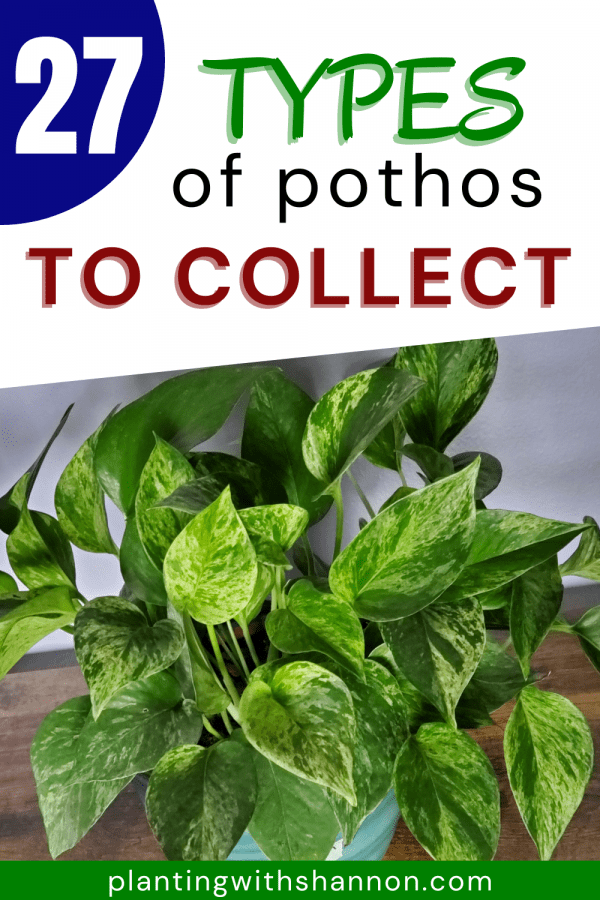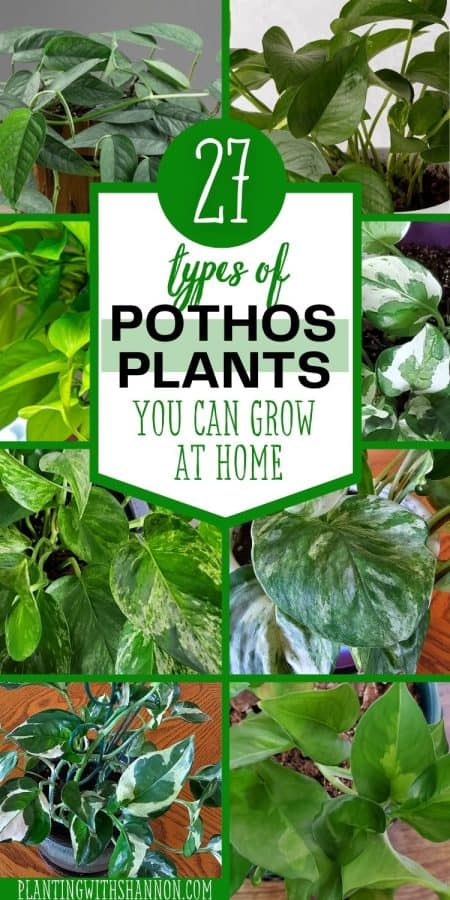Did you know that the pothos plant comes in more than just one variety? There are at least 27 types of pothos plants!
The pothos is a great choice if you’re looking for a versatile and easy-care indoor plant. This family of plants comes in many varieties, so there’s sure to be one perfect for your home.
With just a little bit of care, these plants will thrive in your indoor space and add some green beauty to your home.
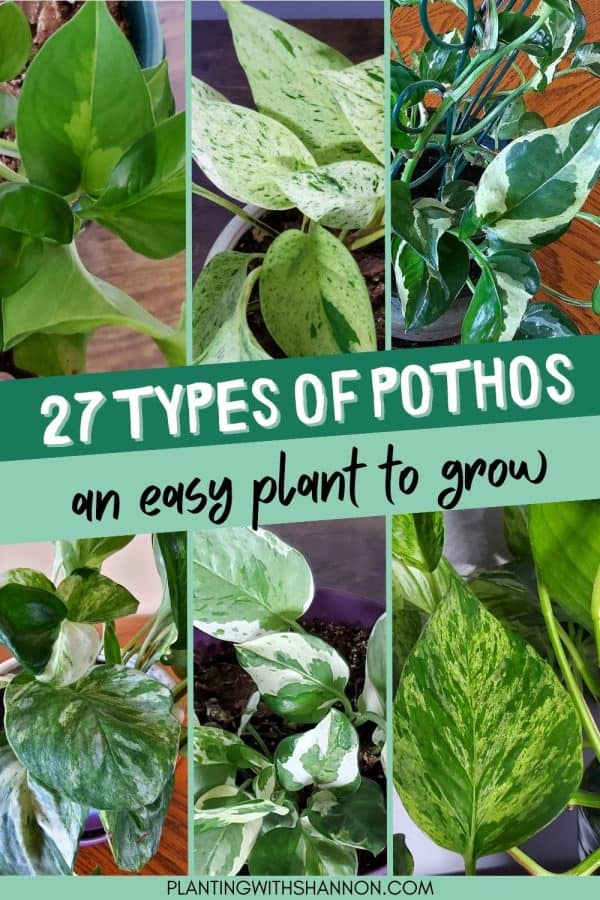
Epipremnum aureum Varieties of Pothos
Epipremnum aureum is considered to be the original species of pothos. This plant is native to Mo’orea, an island in French Polynesia.
Golden Pothos (Epipremnum aureum)

The most common variety of pothos, the golden pothos, is easily recognizable with its variegated green and yellow leaves. Like all pothos, the leaves have a heart shape and a waxy coating.
This plant is considered a fast grower and can survive in a variety of light conditions from low light to bright, indirect light. Though it tolerates many light conditions you will get the best variegation and fastest growth with brighter light.
Marble Queen Pothos (Epipremnum aureum ‘Marble Queen’)
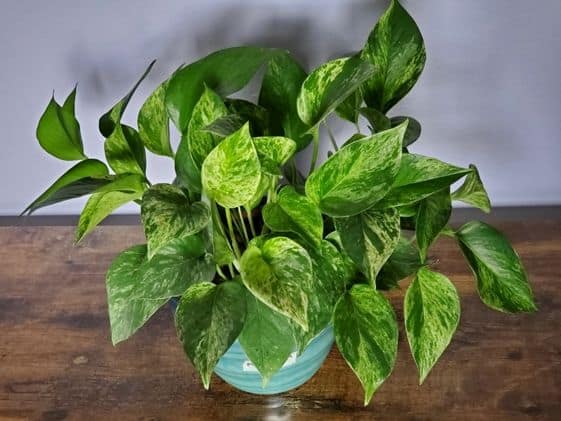
The marble queen pothos has beautiful, variegated leaves that are shades of green, white, and cream. This type of pothos is a fast grower compared to some other varieties of pothos.
Like most pothos, the marble queen does best in bright, indirect light but can also tolerate lower light conditions. One thing to remember is the less light it has, the fewer variegated leaves it will produce.
This plant is easy to care for and makes a great choice for beginners.
Jade Pothos (Epipremnum aureum ‘Jade’)
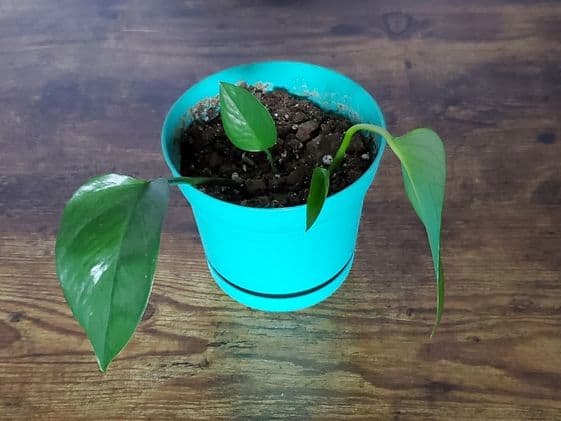
The jade pothos plant is a beautiful solid green variety of pothos. This plant is a fast grower and can grow to be quite long.
The jade pothos does best in bright, indirect light but can also tolerate lower light conditions. Lower light will make the jade pothos grow slower and make the vine stretch more than in higher light conditions, but since it is a non-variegated variety, it will not affect the color of its leaves.
This is another easy to care for plant that is great for beginners.
Manjula Pothos (Epipremnum aureum ‘Manjula’)

The Manjula pothos is a beautiful variety of pothos with large, heart shaped leaves. The leaves have a mixture of light and dark greens along with streaks of white on them.
The Manjula pothos does best in bright, indirect light but can also tolerate lower light conditions. Lower light will make the Manjula pothos grow slower and reduce the lovely variegation of its leaves.
Neon Pothos (Epipremnum aureum ‘Neon’)
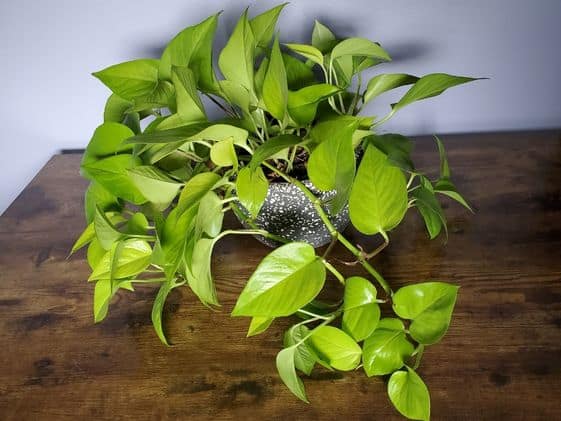
The neon pothos is a bright, solid neon green variety of pothos. It gets its name from the color of its leaves.
This plant does best in bright indirect light but can also tolerate lower light conditions. The neon pothos is considered a fast grower and can quickly reach several feet in length.
Pearls and Jade Pothos (Epipremnum aureum ‘Pearls and Jade’)
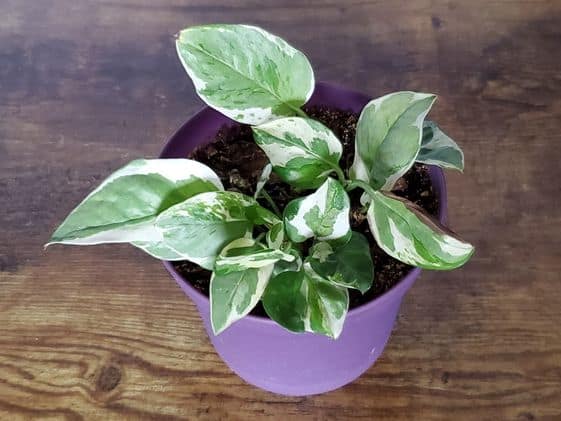
The pearls and jade pothos is a beautiful variety with variegated leaves that are shades of green and white. The white spots on a pearls and jade tend to have green splotches in them.
This variety tends to have smaller leaves than other varieties and will also grow slower than the larger varieties.
Like the other pothos types, it does best in bright, indirect light.
N’Joy Pothos (Epipremnum aureum ‘N’Joy’)
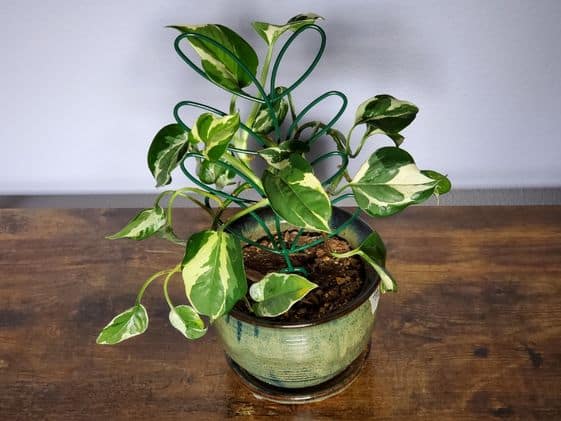
The N’Joy pothos is another beautiful variety with variegated leaves of green and cream. At first glance, it looks very similar to pearls and jade, though it has one main difference. Unlike pearls and jade, a n’joy does not get green splotches in the white parts of the leaves.
This plant does best in bright indirect light but can also tolerate lower light conditions. The N’joy pothos is considered a slow grower and its leaves are smaller than some varieties of pothos.
Glacier Pothos (Epipremnum aureum ‘Glacier’)
The Glacier pothos is a beautiful variety of pothos with shades of green and white variegation.
Though this plant looks similar to both the n’joy and pearls and jade, it is a different plant. The leaves are smaller than the other two varieties and tend to be more rounded, though they maintain the standard heart shape that all pothos have.
The coloring is also slightly different with the white spots being longer and looking more like a streak of white.
Like most pothos, this plant does best in bright indirect light but can tolerate lower light conditions.
Jessenia Pothos (Epipremnum aureum ‘Jessenia’)
The Jessenia pothos is a beautiful variety of pothos with variegated leaves that are shades of green and yellow-green. Jessenia can be confused with marble queen, though the marble queen leaves are lighter and jessenia has no white or cream color on its leaves.
This variety does best in bright, indirect light and is considered a slower grower than some.
Snow Queen Pothos (Epipremnum aureum ‘Snow Queen’)
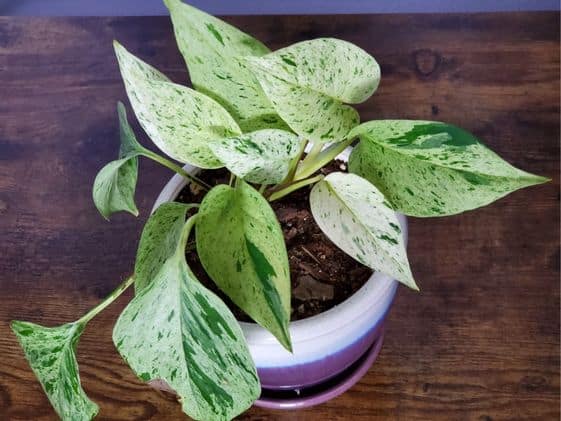
The Snow Queen pothos is a beautiful, variegated plant with leaves that are white with splotches of green.
For the best coloring, this variety needs to be kept in bright, indirect light. Lower light levels will cause it to start producing greener leaves with less variegation.
The Snow Queen pothos is a slow grower partly due to the limited amount of green the leaves have.
The less green it has, the less chlorophyll it has meaning the less photosynthesis it can do. This means it has less energy for new growth.
Global Green Pothos (Epipremnum aureum ‘Global Green’)
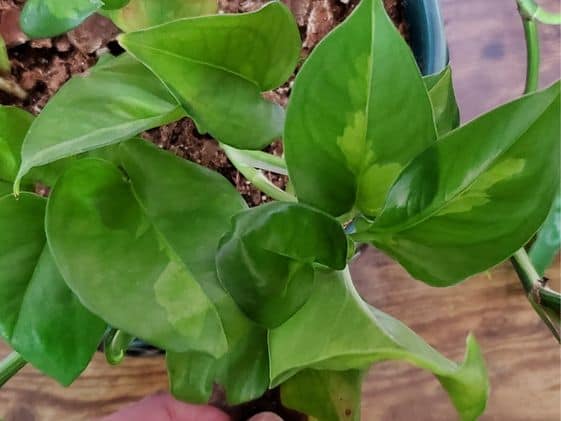
The Global Green pothos is a variegated plant with leaves that are shades of green. The leaves tend to have a darker green on the outsides of the leaves with a lighter green on the middle part of the leaves.
This plant does best in bright indirect light but can tolerate lower light conditions. The global green pothos is a quicker grower than some of the other variegated varieties due to it not having any white on its leaves.
Shangri La Pothos (Epipremnum aureum ‘Shangri La’)
The Shangri La pothos is a beautiful, variegated plant with leaves that are shades of green and yellow just like the golden pothos. The main difference, and the thing that makes this plant really unique, is the shriveled look of the leaves.
Instead of laying flat and open like most pothos, this variety keeps its leaves curled up and closed-looking giving it the common name of the sleeping pothos.
This variety does best in bright indirect light but can tolerate lower light conditions. Though in lower light conditions its leaves may grow open and flat instead of curled up.
This pothos variety may not be for everyone as its leaves make the plant look stressed and it may be more difficult to know if the plant is happy or needs attention.
Emerald Pothos (Epipremnum aureum ‘Emerald’)
The Emerald pothos is a beautiful, variegated plant with leaves that are shades of light and dark green.
This pothos is often confused with global green as they both have green on green variegation. The difference is the emerald pothos have darker green towards the center of the leaves and lighter green on the outside of the leaves, the opposite of the global green.
The emerald pothos is another fast grower and can tolerate a variety of light levels, though it prefers bright indirect light.
Harlequin Pothos (Epipremnum aureum ‘Harlequin’)
The Harlequin pothos is a beautiful, variegated plant that looks similar to the manjula pothos. The main difference between a harlequin pothos and a manjula pothos is that the harlequin is supposed to have more white and light green than the manjula variety.
I will add that there is some controversy over this variety. Some people say that there is no such thing as a harlequin pothos, others say there is. Those who say this isn’t a separate variety claim that the pictures online are just pictures of the manjula pothos edited to look lighter.
Another theory is that the harlequin pothos is just a plant grown from highly variegated manjula cuttings. Unfortunately, there is no proof, either way, of where the harlequin pothos came from and if it’s a true variety or not. I included it in this list just in case it turns out to be a true variety of pothos.
Hawaiian Pothos (Epipremnum Aureum ‘Hawaiian’)

The Hawaiian pothos is very similar to the golden pothos, similar enough that they are difficult to tell apart. The Hawaiian pothos has slightly lighter variegation that can include white with green and yellow leaves.
The biggest difference between the two is in the leaf size. The Hawaiian pothos will get larger leaves indoors than the golden pothos will, but even this is difficult to tell on a young plant.
Epipremnum pinnatum Varieties of Pothos
There are a few different Epipremnum pinnatum varieties of pothos that are grown indoors. The main difference between these plants and the Epipremnum aureum varieties is that they have differently shaped leaves.
Dragon’s Tail Pothos (Epipremnum pinnatum)

The Dragon’s Tail pothos gets its name from its leaves which are long and narrow with pointed tips, similar to the tail of a dragon. It has glossy green leaves that will eventually develop fenestrations (splits in the leaves) as it matures.
This pothos does best in medium to bright indirect light.
Cebu Blue Pothos (Epipremnum pinnatum ‘Cebu Blue’)

The Cebu blue pothos is a beautiful variety of pothos with blue-green leaves that have a silvery blue appearance. It’s a fast grower and can get 6 feet or longer indoors. It’s a climbing plant so it will need something to climb on, a trellis or moss pole would work well.
This pothos does best in bright indirect light but can tolerate lower light conditions.
Baltic Blue Pothos (Epipremnum pinnatum ‘Baltic Blue’)

The Baltic blue pothos is similar to the Cebu blue pothos in that it has beautiful blue-green leaves. Though similar, the baltic blue leaves are darker than the Cebu blue and will produce fenestrations earlier than the Cebu blue does.
This pothos does best in bright indirect light but can tolerate lower light conditions.
Skeleton Key Pothos (Epipremnum pinnatum ‘Skeleton Key’)
The skeleton key pothos gets its name from the shape of its mature leaves.
When young the leaves resemble most other Epipremnum varieties but as the plant matures the leaves begin to be wide at the base and narrow significantly towards the tip of the leaf making it look like a skeleton key or sting ray.
The best way to get a skeleton key pothos to show its unique leaves is to give it something to climb like a trellis or moss pole.
Scindapsus Varieties of Pothos
The Scindapsus genus is not a part of the Epipremnum genus but is included here because these plants are oftentimes labeled as varieties of pothos.
The scindapsus varieties are also sometimes called trebi pothos along with the individual names below.
Satin Pothos (Scindapsus pictus ‘Argyraeus’)

The satin pothos is a beautiful plant with leaves that have silvery spots on them. These leaves also do not have the waxy sheen that many of the Epipremnum aureum have.
This pothos does best in bright indirect light.
Silver satin pothos (Scindapsus pictus ‘Exotica’)
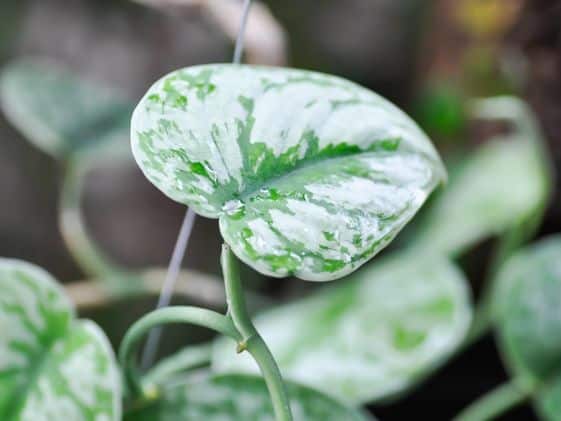
The silver satin pothos is similar to the satin pothos in that it has silvery spots on its leaves. The biggest difference is that the silver saturation is much higher giving the plant an almost entirely silver appearance.
This pothos does best in bright indirect light.
Scindapsus pictus ‘Jade Satin’
The jade satin pothos is set apart from the satin and silver satin pothos as it has dark, jade green leaves with no silver spots.
This pothos does best in bright indirect light and is known as a slow grower even though it is not variegated.
Scindapsus pictus ‘Silver Splash’
The silver splash pothos is similar to the silver satin in that it has high silver saturation, however, the silver spots are more mottled and the silver is more muted in color.
This pothos does best in bright indirect light.
Scindapsus pictus ‘Silvery Ann’

The silvery ann pothos is similar to the silver satin in that it has mottled silver leaves, however, there is more variegation in this variety. It also has more chaotic variegation on the leaves.
This pothos does best in bright indirect light.
Scindapsus pictus ‘Silver Lady’
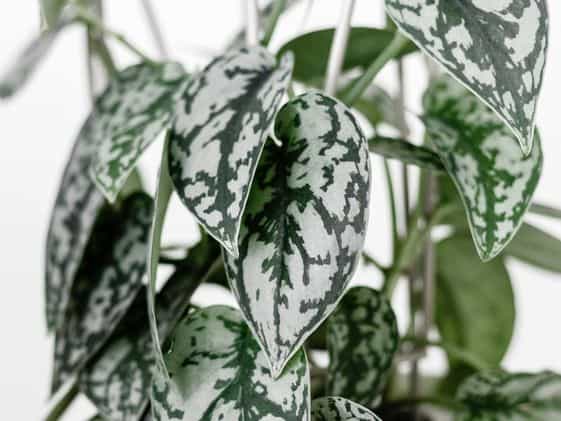
The silver lady pothos is similar to the other Scindapsus plants in that it has mottled silver leaves. The difference is that the leaves of the silver lady have more of a splash of silver on its leaves.
This pothos does best in bright indirect light.
Scindapsus treubii ‘Moonlight’
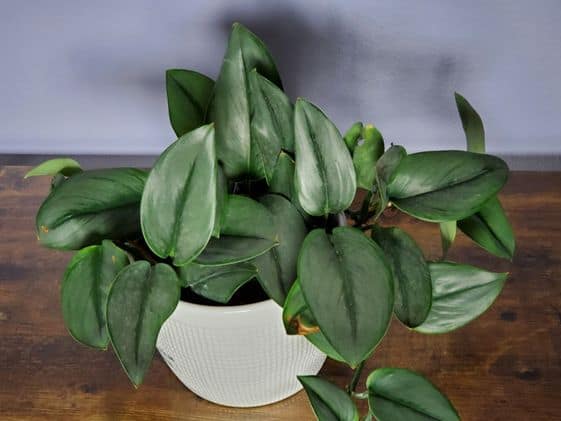
The moonlight variety has leaves that are silvery green. Unlike all of the Scindpasus pictus varieties, this variety doesn’t have spots of silver, instead the whole leaf is silvery green.
It does best in bright indirect light.
Scindapsus treubii ‘Nearly Black’
The Scindapsus treubii gets its common name, nearly black, name from the deep, dark color of its leaves. The leaves are so dark that they appear to be nearly black.
This plant is a striking addition to any home. It does best in bright indirect light and is known to be a slow grower.
Common Questions About Pothos Plants
Here are a few common questions people have about pothos plants.
How big do pothos plants get?
Pothos plants can get quite large when in their native habitat, reaching up to 60ft long as they climb up a tree.
When kept in a pot indoors, pothos don’t get nearly as big as they do in the wild. Most indoor pothos will only reach about 10 ft in length, though it’s possible for them to get up to 30 ft long with the right growing conditions.
What is the best way to care for a pothos plant?
Pothos are very easy to care for and make a great plant for beginners. These plants are happy in a wide range of conditions and can tolerate some neglect.
Pothos do best in bright, indirect light but can also tolerate low light conditions. Pothos are also good at showing when they need more light. If the vines start growing but not producing leaves, that’s a sign it needs more light.
Water them when they are dry as they prefer their soil to be on the drier side. If they start to look droopy, you waited to long to water. Water them and then increase how often you water by a day or two.
They will do well in most potting mixes and tolerate a wide range of temperatures, though prefer it above 60°F.
Are Pothos Plants Safe for Pets
All varieties of pothos are considered toxic to dogs and cats and should be kept away from any pets in the house.
I have two dogs and two cats and keep several varieties of pothos in my home. My dogs and cats are very good about not eating my plants, so I don’t worry about them.
Knocking my plants down is a different story, but they don’t eat them. And knocking them off their shelves only makes a mess and maybe damages a few leaves. It doesn’t hurt my pets.
If you have a pet that will eat your plants no matter what, then this plant may not be a good option for you.
Only you know your pets and whether they will leave your plants alone or not. If you’re concerned either keep these plants in a room your pets can’t get into, or choose another plant that isn’t harmful to pets.
Related Posts
21 Best Plants To Keep In The Bedroom
Why Is My Pothos So Leggy? (Tips To Make Your Plant Fuller)




